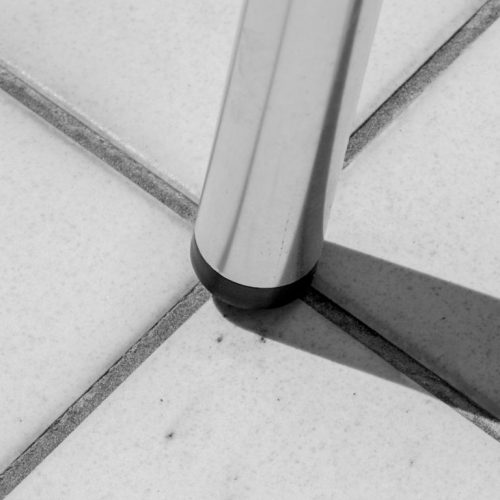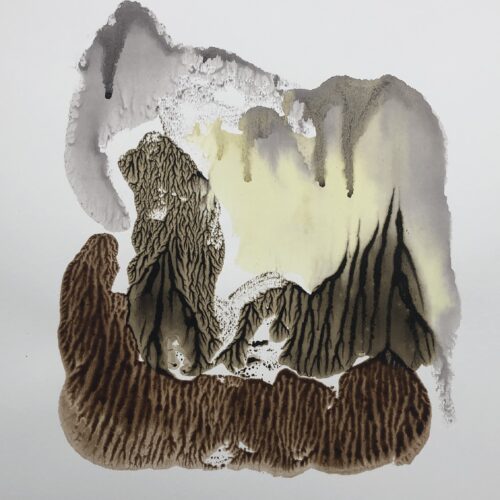
Ekphrastic Poetry
It’s easy to look at a painting, for example, Van Gogh’s yellow bed and chair,, and respond with words. You might write a short story or a narrative poem about someone, possibly Van Gogh himself, who lived here. You might write a poem reproducing what you see in the painting, or something slightly more philosophical about bedrooms and their owners. But what do you write when the painting you are looking at is abstract? There is often a tendency to see shapes and colours in an abstract painting that remind you of a particular object that you can write about but I guess the painter would rather you hadn’t and/or didn’t. However, if we take a particular abstract painting to which the painter has given a non-abstract title then we could use that title to stimulate our writing. I’m thinking, for example, of Albert Irwin’s large abstract canvas called Sky. The very fact of this naming diminishes its abstractness; if you also know that Irwin was a flight lieutenant during WW2, then the streaks of paint begin to take on an “objectness” that represent sky, clouds, and the trails left by dogfighting Spitfires. So maybe that’s a sort of halfway house between abstract painting and representation.
I’ve recently been working with a local abstract artist, Angela Baum, in Bristol and for her recent exhibition she asked me to respond to some of her paintings with a few lines of poetry. I was tempted to find representations of objects while she, as artist, had almost certainly gone for shape and colour combinations and so I tried hard to resist that temptation. On the other hand, she has a recognition of how words work, since she has called her exhibition, Conversations in Colour. While working on my responses I came across two articles which helped to set ekphrastic poetry in response to abstract painting in a new light.
One of these articles (unfortunately the online reference got lost when I inadvertently deleted some of my notes) was by an American art critic analysing the history of the development of abstract art in the USA, claiming that it was a way of allowing artists to move away from the increasing growth of cliché in representative art. But maybe this is a well-known analysis among art historians. The other article was by Patrick Wright in the most recent edition of NAWE’s journal, Writing in Education No.77, Spring 2019, where the author coins the term, “seeing flatly” in order to allow the writer to look at abstract art without referring to the usual expectations. He uses Malevich’s Black Square (Tretyakov Gallery, Moscow) as an example of what looking flatly might mean. He hopes “In this way the domains of poetry and pedagogy can be brought together under a common objective: to see overlooked features of the image, rather than think we have seen all there is to see, then write in and through a broader lens of awareness.” This will give the writer the chance to use the visual image as “the springboard” for their own explorations and not just reproduce a one for one conversion of the visual into the written. Wright also suggests that the writer makes use of some of the ideas of the nineteenth century art historian, Giovanni Morelli, who suggested finding meaning in tiny details. Another of Wright’s suggestions is to use Sigmund Freud’s idea of “evenly-hovering attention” when he listened to clients’ stories.

So here is an example of my attempt to look flatly at one of Angela Baum’s paintings with a nod to Gerard Manley Hopkins on the way:
Glory be to paint for all things dazzled
cut and shaped down estuary spinning
flying out of
To take another aspect of the ekphrastic, which seems to be a very good example of the “flat look” is the work of Paul, a photography student, in his collection of chair/table legs trying to set up a collection of photographs and words to create tension (OCA students can access the discussion here https://discuss.oca-student.com/t/tension-of-a-collection/9961/32). To begin with, he allotted adjectives to each image in his collection, and myself being a firm adherent of the show, don’t tell use of language for writers and photographers alike, I suggested he use nouns instead, which he is now thinking of doing and here is his explanation of the ekphrastic within his work where one of the leg images is accompanied by the word “funeral”.
“I would say in this collection the ekphrastic creates a context for the furniture legs, so the ekphrastic “creates” a funeral (and does not describe the leg)… and this funeral is ankered (sic) or witnessed by a furniture leg – making it “real”. The photograph becomes a window into a larger funeral scene, but we only see the leg and imagine the rest.”
See the work here https://nor.art.blog/
(Thanks to Angela Baum and Paul for allowing me to quote from their work & use their images)
|
|







I liked your lines, Liz. This has reminded me of a creative writing workshop I went to once. We were shown a print of Nighthawks, by Edward Hopper, and asked to write a few lines describing what it said to us. For me there was a whole book in there! I was writing for hours. It’s a scene that thrills me. Does this mean a painting could say more in a very short time than a novel, I wonder?